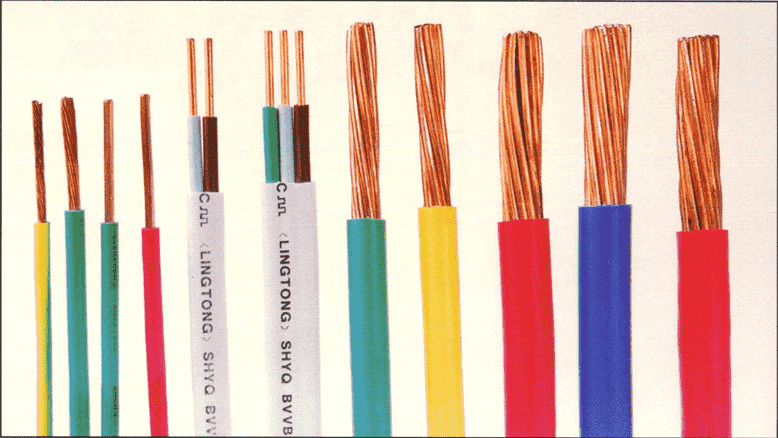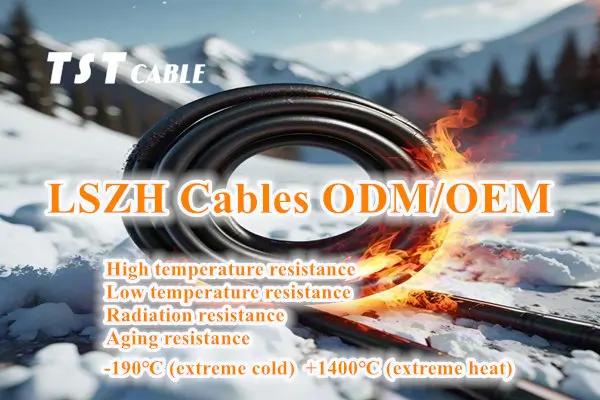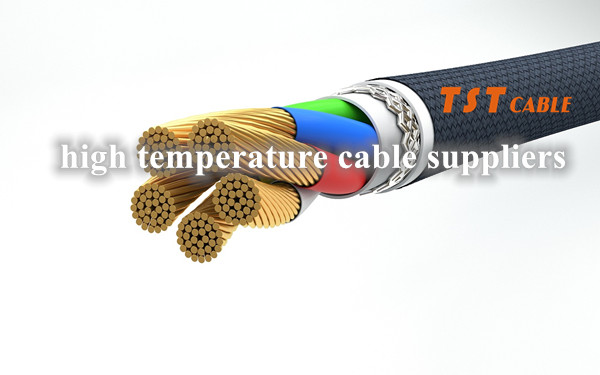Compared to traditional (usually PVC) cables, TST cable’s low-smoke zero-halogen (LSZH) cables offer significant advantages in safety, environmental protection, and specific performance, especially in extreme situations like fires.
The following is a summary of the core advantages of the two cables:
1. Fire Safety: A “Guardian” of Life Safety
This is the core and most important advantage of TST cable’s low-smoke zero-halogen (LSZH) cables.
Extremely Low Smoke:
Traditional cables: When burning, PVC cables produce a large amount of dense, opaque black smoke (smoke density can reach over 600), instantly reducing visibility to a few centimeters, severely hindering escape and fire rescue efforts.
TST cable’s low-smoke zero-halogen (LSZH) cables: When burning, the smoke produced is extremely thin and transparent (smoke density typically ≤100), providing high visibility. This provides valuable “golden time” for evacuation and firefighters, significantly reducing the risk of suffocation and trampling.
Advantages: ✅ Significantly improves the chance of survival in a fire.
Halogen-Free:
Traditional cables contain halogens such as chlorine (Cl) and bromine (Br), which produce highly toxic acidic gases such as hydrogen chloride (HCl) and hydrogen bromide (HBr) when burned. These gases can:
Severely irritate the respiratory tract and eyes, leading to rapid suffocation, poisoning, and even death.
Contact with water forms strong acids (such as hydrochloric acid), which corrode electronic equipment, metal structures, and building reinforcement, causing “secondary damage after the fire.”
TST cable low-smoke halogen-free cables contain no halogens and primarily produce water vapor and carbon dioxide upon combustion, with virtually no toxic or corrosive gases.
Advantages: ✅ Protects personnel health and prevents secondary poisoning; ✅ Protects precision equipment and building structures.
Superior flame retardancy:
Traditional cables: Some PVC cables are flame-retardant (such as ZR-PVC), but they still continuously release toxic fumes when burned.
TST cable low-smoke halogen-free cables typically use inorganic flame retardants such as aluminum hydroxide and magnesium hydroxide. These materials decompose at high temperatures, absorbing heat and releasing water vapor to dilute oxygen, effectively preventing the spread of flames. They quickly self-extinguish after removal from the fire source.
2. Environmental Performance: A green choice throughout the entire lifecycle
Production and Disposal:
Traditional cables: Heavy metal stabilizers such as lead and cadmium may be used during PVC production, making them difficult to degrade after disposal and polluting soil and air when incinerated.
TST Cable Low-Smoke Halogen-Free Cables: Primarily made of polyolefins (such as polyethylene), they are halogen-free and contain no harmful heavy metals, complying with international environmental directives such as RoHS and REACH. Disposal allows for recycling or natural degradation, minimizing the environmental impact.
Advantages: ✅ In line with the trend toward green building and sustainable development.
3. Physical and Electrical Performance: Advantages and Trade-offs
Improved Temperature Resistance:
Many low-smoke halogen-free cables use cross-linked polyethylene (XLPE) insulation, which has a long-term operating temperature of up to 90°C, compared to 70°C for standard PVC cables. Advantages: ✅ Higher current carrying capacity (can carry higher current); ✅ Greater overload capacity, suitable for high-temperature environments (such as equipment rooms and distribution cabinets).
Superior insulation performance:
TST cable’s low-smoke, zero-halogen (LSZH) material offers higher insulation resistance, lower leakage current, and reduced power loss.
Advantages: ✅ More efficient power transmission, particularly suitable for long-distance or high-precision applications.
Physical performance trade-offs:
Flexibility: LSZH material tends to become brittle at low temperatures, requiring a larger bend radius and requiring more careful installation.
Chemical resistance: Generally less resistant to oils and certain chemical solvents than PVC.
Cost: 30%-50% higher than PVC cables of the same specification.
Volume: May require a thicker jacket, resulting in a slightly larger outer diameter.
TST cable, low-smoke, zero-halogen (LSZH) cable, is the preferred choice for power safety and environmental protection.
| Comparative Dimensions | Traditional PVC cables | TST cable, low-smoke, zero-halogen (LSZH) cable. | LSZH Advantages |
| Fire Smoke | Produce heavy smoke and extremely low visibility | Thin smoke, high visibility. | ✅✅✅ Life Safety |
| Toxic Gases | Release highly toxic gases such as hydrogen chloride | Emits virtually no toxic or corrosive gases. | ✅✅✅ Personnel and Equipment Protection |
| Flame Retardancy | Some are flame-retardant, but these are accompanied by toxic smoke | Effectively flame-retardant, self-extinguishing. | ✅✅ Fire Suppression |
| Environmental Protection | Contain halogens, are difficult to degrade, and are polluting | Halogen-free, environmentally friendly, and recyclable. | ✅✅ Green and Sustainable |
| Heat Resistance | Typically 70°C | Typically 90°C or higher. | ✅ Higher Current Carrying Capacity |
| Insulation | General | Superior | ✅ Lower Losses |
| Cost | Low | Higher | ❌ |
| Low-Temperature Flexibility | Good | Poor (brittle) | ❌ |
While TST cable’s low-smoke, halogen-free cable may compromise on cost and low-temperature installation convenience, its advantages in fire safety, personnel protection, equipment protection, and environmental protection are overwhelming. In safety-critical environments like modern buildings, transportation, data centers, hospitals, and schools, choosing TST cable isn’t just an “upgrade,” but a fundamental safety baseline. For home users, it’s a wise investment in your family’s safety.
Also available in:
English





